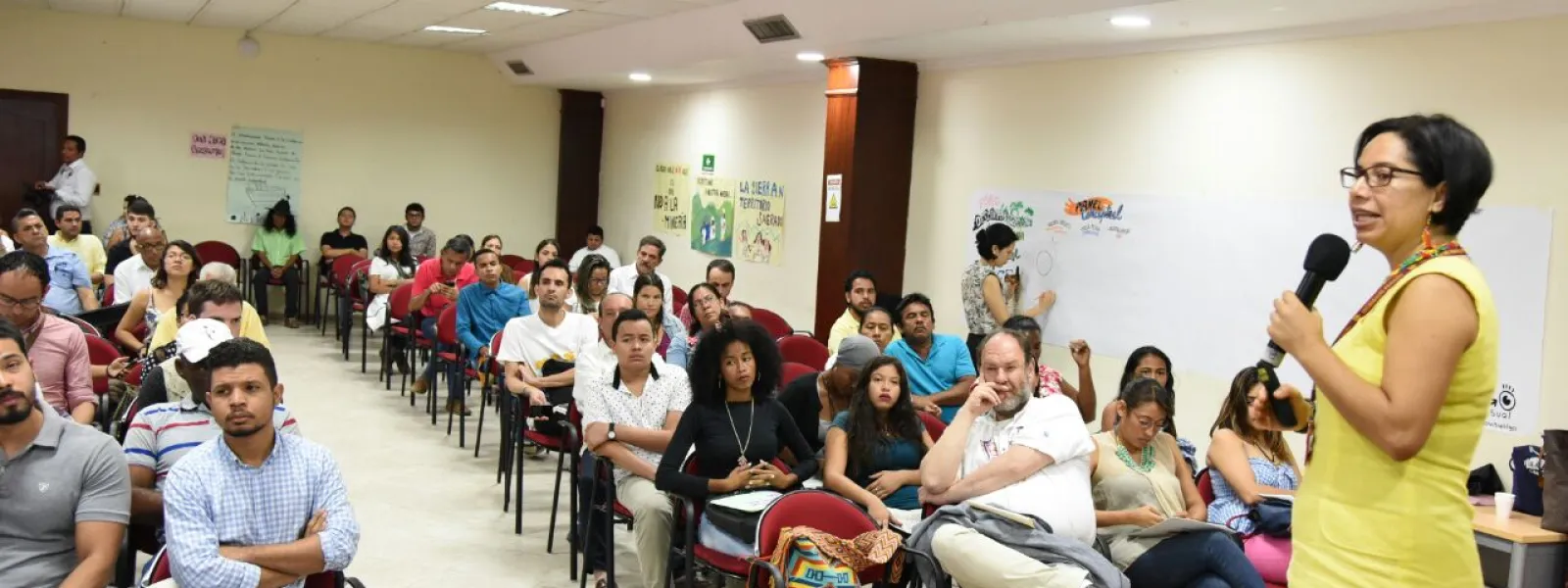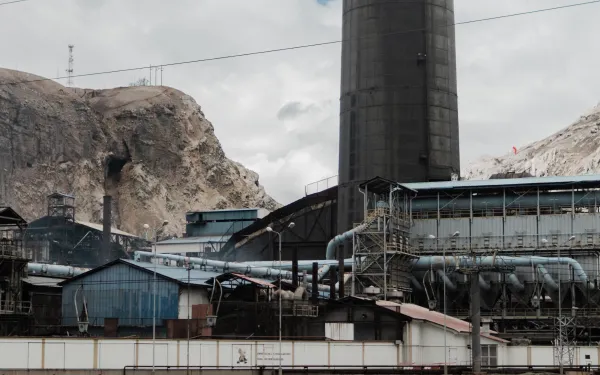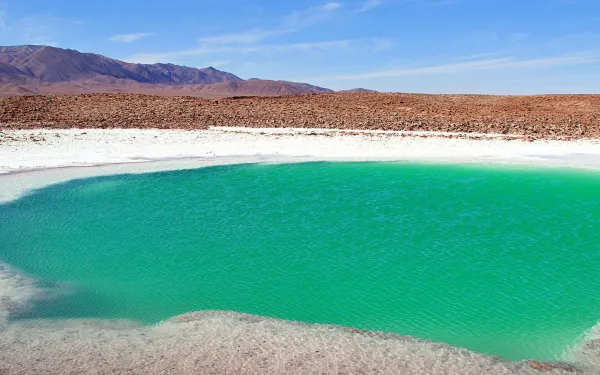
Project
Organizing the Network for Environmental Justice in Colombia
The Network for Environmental Justice in Colombia is an effort to coordinate organizations and legal resources for the protection of human rights and the environment.
The Network was founded in 2010 under the coordination of AIDA and with the help of the Latin American Institute for Alternative Society and Law, the Institute for the Study of Peace and Development, the Inter-Ecclesial Commission for Justice and Peace, and the University of Los Andes, the University of Caldas, and Del Rosario University. The network began with 79 participants and now includes more than 500 people and participating organizations.
The Network’s principal objective is to propose solutions to environmental conflicts in Colombia. It also aims to promote the fair and effective use of international and domestic environmental law, in particular, the right to a clean and healthy environment.
What does the network do?
- Facilitates the exchange of knowledge and information to implement legal strategies in precedent-setting cases. One such project was the Mandé Norte Mine, in which several members of the Network developed a legal strategy, resulting in a judicial decision that established Colombia’s need to perform an independent environmental impact assessment. Most importantly, the decision also mandated that developers obtain the consent of indigenous peoples before moving forward with any projects in their territory.
- Promotes organizational alliances, garners support, and connects legal work in defense of the environment.
- Organizes conversations, forums, and constructive debates on environmental issues.
- Provides access to legal resources including laws, court decisions, articles and legal analysis, and facilitates communication through its website and social media channels.
- Advises law students through the AIDA volunteer program. In doing so, the Network strengthens the capacity for environmental law in Colombia.
Partners:

The treaty protecting life on the high seas: Why should governments ratify it?
The ocean covers two-thirds of the planet. It is so immense and vast that 64% of its waters are outside any border, in a space known as the high seas.It is an area that lies outside national jurisdictions and represents 40% of the Earth's surface.Because of the wealth of marine life it harbors - including species new to science - the high seas are one of the world's greatest reserves of biodiversity. It is also a source of food and oxygen, regulates the climate, cushions the impacts of the climate crisis and sustains the livelihoods of fishing and tourism communities.Despite their importance, only 1.2% of the waters of the high seas have international protection.To fill this gap, in June 2023, UN member countries formally adopted an agreement to protect biodiversity in the high seas, which needs ratification by at least 60 countries to enter into force.Find out how many and which countries have ratified the treaty. As a reservoir of global common goods, the protection and sustainable use of the high seas is a right and an obligation of all governments. What does the High Seas Treaty state?The High Seas Treaty - short name for the Agreement on the Conservation and Sustainable Use of Marine Biological Diversity of Areas beyond National Jurisdiction (BBNJ Agreement) - is universal and can benefit all countries, even those that are not party to the United Nations Convention on the Law of the Sea (UNCLOS), such as Colombia, El Salvador, Peru and Venezuela.The treaty contains the following key elements:Area-based management tools. The treaty establishes a legal framework and a clear process for creating networks of marine protected areas, which can provide comprehensive protection for biodiversity in the high seas from multiple activities, maintaining the health and resilience of this part of the ocean.Environmental impact assessments. Under the treaty, any new activity on the high seas is subject to detailed, modern environmental impact assessments that include the cumulative impacts of multiple activities affecting the same ecosystem. Developing countries will be supported to take part in this task.Fair and equitable sharing of benefits from marine genetic resources. The agreement establishes obligations to share monetary and non-monetary benefits from the utilization of genetic resources found in the high seas (genetic material of any animal, plant or microbe) to develop new medicines, for example.Capacity building and technology transfer. The treaty provides for the provision of financing and technology transfer on fair terms for developing countries to increase their marine scientific and technological capacity, including data exchange, infrastructure development and improvement, and respect for traditional knowledge. Why should governments ratify the High Seas Treaty?Having a High Seas Treaty took more than two decades, including five years of negotiations at the UN. To secure this historic breakthrough, the agreement must enter into force - become law under international law - which will occur 120 days after 60 countries have ratified it. So far, 28 countries have ratified the treaty.Ratification means that countries, in addition to signing it, give their formal consent to the treaty, which often involves ensuring that their national laws are consistent with it.There are many reasons why ratification of the agreement will benefit developing countries, particularly those in Latin America and the Caribbean. Some of these are:The treaty brings us closer to environmental justice. It will benefit countries historically excluded from access to the resources of the high seas, providing them with new opportunities for technological, scientific and economic development. It will also allow all countries to be active players in a global platform for decision-making, coordination and cooperation for the protection and sustainable use of these resources.The treaty allows for the conservation of key ecosystems. Under the treaty, all countries will be able to propose marine protected areas on the high seas, including landlocked countries (such as Bolivia and Paraguay). This will allow the protection of areas rich in biodiversity and endemic species in Latin America, such as the Salas y Gómez & Nazca submarine mountain ranges (Chile-Peru) or the Thermal Dome in the Central American Pacific.The treaty benefits local livelihoods and economies. By promoting a healthy and resilient high seas, the treaty will have positive effects on coastal areas and economic activities that depend on migratory species, such as whale and turtle watching, diving, tourism, commercial and sport fishing. Highly migratory species such as squid are vital to Latin American economies.The treaty provides a voice in decision-making on the high seas. Countries that have signed the treaty will participate in the meetings of the Preparatory Commission and those that ratify it will be able to participate in the Conference of the Parties (COP) of the agreement, the first version of which will take place one year after its entry into force, where key aspects of its implementation and the realization of its benefits will be decided.The call is therefore for all countries to ratify the High Seas Treaty, thus protecting 64% of our ocean, which today lacks effective protection.It is time to act for marine life and for future generations.
Read more
Families of La Oroya demand Peru comply with Inter-American Court ruling
One year after the decision, the state has still not implemented the ordered reparations. The population lacks comprehensive health care and is once again exposed to toxic contamination due to the reactivation of the La Oroya smelter complex, which is operating without adequate environmental management.One year after the Inter-American Court of Human Rights ordered the Peruvian state to provide comprehensive reparations to the residents of La Oroya, after finding it responsible for violating their rights, the victims are still waiting for the ruling to be implemented and for state to comply with its international obligations."It's already been a year since the ruling was announced, how much longer will we have to wait?" asked Yolanda Zurita, a resident of La Oroya and a petitioner in the case. "Enough is enough! We demand that the Peruvian state immediately comply with the ruling of the Inter-American Court, which will benefit not only the victims of the case, but also the population of La Oroya and the country exposed to toxic substances from the indiscriminate development of extractive and industrial activities in our territories."On March 22, 2024, in a landmark decision for the protection of a healthy environment in Latin America, the Court responded to the long and tireless search for justice by the families of La Oroya, who have been affected for decades by the extreme levels of contamination from the La Oroya Metallurgical Complex (CMLO) and the lack of adequate protective measures by the State, which today ignores the ruling and underestimates its importance.Although the Court ordered the State to ensure that CMLO's operations comply with international environmental standards and to prevent and mitigate damage to the environment and human health, the opposite is currently the case: the complex has reactivated its operations without having modernized its facilities to prevent and mitigate the environmental and health risks it generates for the population.It is urgent that the CMLO stops polluting and that the Peruvian State adopts the measures required by the Court to modernize it in accordance with international environmental standards of environmental protection, in compliance with the ruling."With the reactivation of the metallurgical complex, the people of La Oroya are once again being exposed to levels of pollution that endanger their lives; the Inter-American Court's ruling is clear and the State is obligated to comply," said Rosa Peña, senior attorney with the Inter-American Association for Environmental Defense (AIDA). "The delay in complying with the ruling is re-victimizing the families who have been demanding justice for more than 20 years."The court also ordered the state to provide free medical care to the victims and to guarantee specialized care to residents with symptoms and illnesses related to contamination from the mining and metallurgical activities. Today, however, comprehensive health care is not guaranteed in La Oroya. It is necessary that the State, through and in coordination with the Ministry of Health, the Regional Health Directorate of Junín, the General Directorate of Environmental Health, and health care providers, create and implement the protocol for comprehensive care for victims in La Oroya, as established by the Court.The ruling set a historic precedent for the control of industrial pollution by states. For the Peruvian State to make real progress in its implementation, it is imperative that the Attorney General's Office issue the Compliance Resolution."Despite the deadlines set by the Inter-American Court for the Peruvian State, there has been virtually no progress in the implementation of the ruling," said Christian Huaylinos, coordinator of the legal department of the Pro Human Rights Association (APRODEH). "Above all, the nature of the case must be taken into account, which implies that La Oroya has been classified as a sacrifice zone due to the high levels of contamination; therefore, the need to fully compensate the victims is urgent." Background of the caseLa Oroya is located in the central mountain range of Peru, in the department of Junin, 176 km from Lima. In 1992, the US company Cerro de Pasco Corporation installed the La Oroya Metallurgical Complex (CMLO) to process mineral concentrates. The complex was nationalized in 1974 and operated by the state under the name Centromin Peru until 1997, when it was taken over by Doe Run Peru, which operated it until 2009. In short, the CMLO is over 100 years old.In La Oroya, most of the people affected by the CMLO contamination, including children, have lead levels higher than those recommended by the World Health Organization. In some cases, they have registered higher levels of arsenic and cadmium, in addition to stress, anxiety, skin problems, stomach problems, chronic headaches, and respiratory or cardiac problems, among others.In the absence of effective responses at the national level and on behalf of the victims, an international coalition of organizations filed a complaint against the Peruvian State with the Inter-American Commission on Human Rights in 2006. In October 2021, the Commission found the Peruvian government responsible and referred the case to the Inter-American Court. In October 2022, more than 16 years after the international complaint was filed, the victims, represented by AIDA and APRODEH with the assistance of Earthjustice, brought the case before the Court. Press contactsVíctor Quintanilla (Mexico), AIDA, [email protected], +52 5570522107María Nieve Sullón (Peru), APRODEH, [email protected], +51 984926868
Read more
Why is lithium mining in Andean salt flats also called water mining?
By Víctor Quintanilla, David Cañas and Javier Oviedo* According to official figures, approximately 2.2 billion people worldwide lack access to drinking water.Despite this panorama, threats to this common good from overexploitation and pollution are increasing. One such threat is the accelerated extraction of lithium in Latin American countries, driven by corporate and state actors to meet the energy transition needs of the global North.Lithium extraction involves enormous water consumption and loss and is essentially water mining.On the continent, the advance of the lithium industry particularly threatens the salt flats and other Andean wetlands of the Gran Atacama region—located in the ecological region of the Puna, on the border of Argentina, Bolivia and Chile—where more than 53 percent of the mineral’s resources (potentially exploitable material) are located.Lithium mining exacerbates the natural water deficit in the area, threatening not only the salt flats, but also the many forms of life that live there. Where does the water used in lithium mining come from?First, it’s necessary to point out that salt flats are aquatic ecosystems located at the bottom of endorheic or closed basins. There, rivers do not flow into the sea but into the interior of the territory, so the water forms lakes or lagoons often accompanied by salt flats due to evaporation.In the salt flats, freshwater and saltwater usually coexist in a delicate balance that allows life to survive.The regions with salt flats, such as the Gran Atacama, are arid or semi-arid, with high evaporation and low rainfall. There we find freshwater aquifers at the foot of the mountains and brine aquifers in the center of the salt flats, both connected and in equilibrium.Brine is basically water with a high salt content, although the lithium mining industry considers it a mineral to justify its exploitation and minimize the water footprint of its activities.In addition to being essential for life, the waters of the salt flats are a heritage resource because they are very old—up to tens of thousands of years—and have been the livelihood of the indigenous people who have inhabited the Puna for thousands of years.When the mining industry moves into a salt flat, it threatens the natural balance and directly affects the relationship between water and the social environment, as well as the relationship between water and other forms of life.To extract lithium from a salt flat, the traditional procedure is to drill the salt flat, pour the brine into large ponds, wait for the water to evaporate so that the lithium concentration increases, send the lithium concentrate to an industrial plant and subject it to chemical treatment to separate the lithium from other salts and finally obtain lithium carbonate or hydroxide: a raw material used mainly in the manufacture of batteries.The continuous and large-scale extraction of brine from saline aquifers alters the natural balance of groundwater. As a result, areas that were previously filled with brine are emptied, causing freshwater from nearby aquifers to move in and occupy those spaces, becoming salinized in the process.The final processes to extract lithium carbonate and separate it from the rest of the compound also require water, which is drawn from surface or underground sources that also supply local communities.Therefore, the water used in lithium mining comes from:Underground freshwater and brine aquifers.Surface sources such as rivers and vegas (land where water accumulates). Therefore, the inherent risk of lithium mining is the overexploitation of these water sources. How much water does lithium mining use?The extraction of lithium by the methods described above involves an enormous consumption and loss of water, which is not returned to the environment because it completely used up, because its properties change, or because it is simply lost through evaporation.According to scientific data, the average water overconsumption in lithium mining is as follows:150 m3 of fresh water used to produce one ton of lithium.350 m3 of brine per ton of lithium.Between 100 and 1000 m3 of water evaporated per ton of lithium produced. To illustrate the loss of water resources in lithium mining, the water lost to evaporation is equivalent to the total water consumption of the population of Antofagasta (166,000 people) for two years. This Chilean city is located 200 km from the Salar de Atacama, where more than 90 percent of the country's lithium reserves are located.In addition to water depletion, lithium mining can also contaminate the resource by producing wastewater containing toxic substances. Our vital relationship with waterUnlike the mining industry, which sees water as just another resource to be exploited, the indigenous communities living in the area have an ancestral connection to the resource on which their economic and productive activities depend, as well as their customs, traditions and worldview.These communities must now confront the pressures on water from the advance of lithium mining, driven by outside interests.But they are doing so with courage, developing processes of defense of water and territory.Let us learn from them to defend a common good without which no way of life is possible.Learn more about the impacts of lithium mining on Andean salt flats in this StoryMap (in Spanish)Watch the recording of the webinar “Evidence of hyperconsumption of water in lithium extraction and production” (in Spanish) *Víctor Quintanilla is AIDA's Content Coordinator; David Cañas and Javier Oviedo are scientific advisors.
Read more